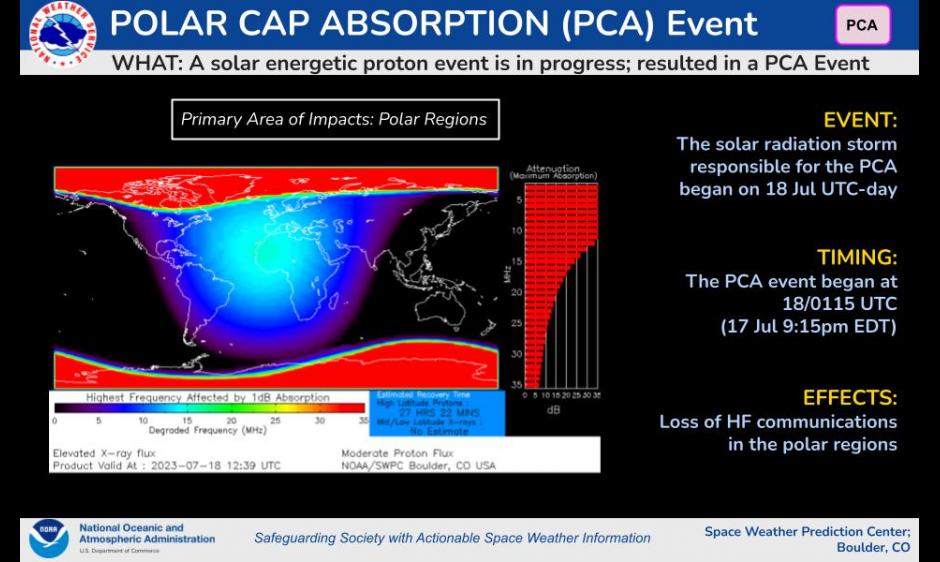[ Skywatchers ] [ Main Menu ]
47519
From: Eve, [DNS_Address]
Subject: Goes Proton Flux graph warning threshold
|
(see link for real time graph) Proton Event products are issued for several thresholds and for two particle energy levels. The ≥10 MeV products match the NOAA Solar Radiation Storm (S-scale) thresholds (10, 100, 1000, 10000, 100000 pfu), based upon values observed or expected on the primary GOES satellite. The ≥100 MeV products are based on a single flux threshold of 1 proton flux unit (pfu). Proton Event WARNINGS are forecasts of a proton event and are issued by SWPC under two conditions: warning of the expected ONSET of a Proton Event, and warning of the expected PERSISTENCE of a Proton Event that is already in progress. The ≥10 MeV Integral Flux WARNING is issued based upon the expectation of reaching or exceeding flux levels of 10 pfu. The ≥100 MeV Integral Flux WARNING is issued based on the expectation of reaching or exceeding flux levels of 1 pfu. Proton Event WARNINGS include a specific indication of what condition - Onset or Persistence - applies to the WARNING. The WARNING period is expressed in terms of “Valid From” and “Valid To” times. If needed, the warning period may be extended by means of an EXTENDED WARNING. EXTENDED WARNINGS always have the same “Valid From” time as the original WARNING, with a revised “Now Valid Until” time specified in the message. The ≥10 MeV Integral Flux WARNING includes the predicted level of activity based on the NOAA S-scale. Proton Event ALERTS are issued upon confirmation of ≥10 Mev or ≥100 MeV Integral Flux exceeding certain thresholds. Initial ALERTS for ≥10 MeV and ≥100 MeV energies are issued for integral flux reaching or exceeding 10 pfu and 1 pfu, respectively. Higher threshold ≥10 MeV ALERTS are also issued for threshold exceedance of 100, 1,000, 10,000, and 100,000 pfu, matching the thresholds described in the NOAA S-scale. Once the Proton Flux has dropped below a given threshold, a Proton Event SUMMARY is issued, specifying the start, maximum, end times, and maximum flux observed for the event, along with the corresponding NOAA S-scale. Because flux levels can drop slowly, the time of a "confirmed" drop below threshold can sometimes take several hours to determine. Higher threshold products for ≥100 MeV flux levels, such as 100 pfu, are being considered for future implementation. Solar Proton Events at Earth can occur throughout the solar cycle but are most frequent in solar maximum years. SPEs result from fast coronal mass ejections. During an SPE, satellites experience dramatically increased bombardment by high-energy particles. Fluxes of particles with energies ≥ 10 MeV can reach 43,500 protons/cm2/sec/ster. Single Event Upset rates in spacecraft electronics increase with high fluxes since there is a higher likelihood of impact on a sensitive location. In addition, these high energy particles can access the polar ionosphere and create an enhanced region of ionization (called the ‘D-Region’) which interferes with HF radio communication in these areas. High-energy particles can reach Earth anywhere from 20 minutes to many hours following the initiating solar event. The particle energy spectrum and arrival time seen by satellites varies with the location and nature of the event on the solar disk. |
47521

From: Eve, [DNS_Address]
Subject: Polar+ Cap Absorption Event in Progress since 18 July, 2023 UTC-day
URL: https://www.swpc.noaa.gov/news/polar-cap-absorption-event-progress-18-july-2023-utc-day
|
https://www.swpc.noaa.gov/news/polar-cap-absorption-event-progress-18-july-2023-utc-day Polar Cap Absorption Event in Progress since 18 July, 2023 UTC-day published: Tuesday, July 18, 2023 13:22 UTC A Polar Cap Absorption (PCA) event has been in progress since the evening of Monday, 17 July, 2023 EDT. |
Responses:
[47531]
47531

From: Eve, [DNS_Address]
Subject: Re: Arctic & Antarctic Might See Radio Blackouts for Days
URL: https://www.cbsnews.com/news/solar-storm-poles-radio-blackouts-cannibal-cme-erupts-from-sun/
|
WORLD Arctic & Antarctic may see radio blackouts could last for days from "cannibal" CME erupts from sun BY LI COHEN JULY 18, 2023 / 5:13 PM / CBS NEWS The ongoing solar storm has hit the planet's polar regions, potentially causing a days-long radio blackout, NOAA said on Tuesday. The impact has hit as a "cannibal" coronal mass ejection makes its way to Earth from the sun, experts say. The potential radio blackouts are part of a Polar Cap Absorption, which is when high-frequency and very high-frequency radio waves in the ionosphere are absorbed, while low-frequency and very low-frequency radio waves are reflected at lower altitudes than usual. NOAA said the event has been in progress since Monday evening at roughly 9:15 p.m. ET. The event was caused by a massive cloud of plasma coming off the sun, known as a coronal mass ejection (CME), as well as a strong M5 solar flare. Those two eruptions triggered a minor solar radiation storm that sent energetic protons to Earth. "PCA events can prevent the ability to communicate via HF radio propagation around the polar regions and can last for hours to days," NOAA said Tuesday. "This event is likely to continue throughout 18 July and perhaps into 19 July." Twitter caption for image: A PCA event began the evening of Monday, 17 July, 2023, starting at approximately at 9:30pm EDT. PCA events can prevent the ability to communicate via HF radio propagation around the polar regions and can last for hours to days. Visit https://swpc.noaa.gov for the latest info. |
Responses:
None
[ Skywatchers ] [ Main Menu ]